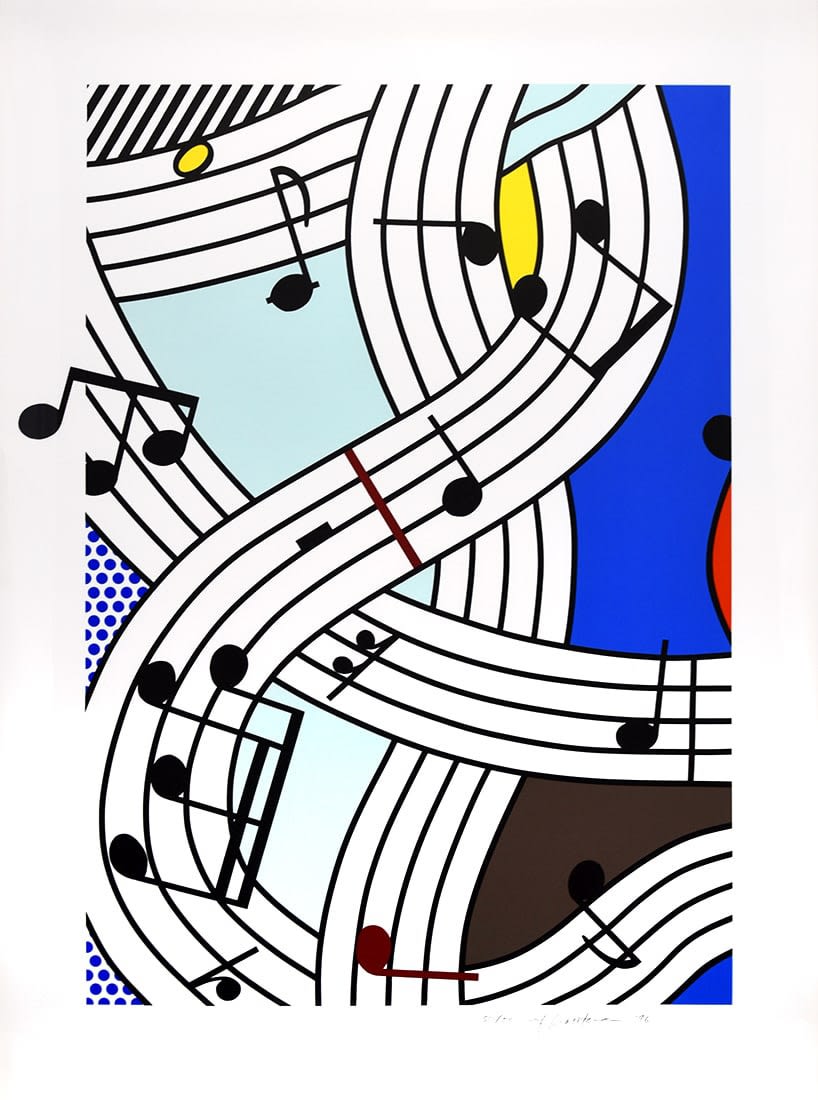
Roy Lichtenstein: The Comic Book Pioneer
Roy Lichtenstein burst onto the Pop Art scene in the early 1960s, turning heads with his bold reinterpretations of comic book imagery. His paintings, characterised by the use of Ben-Day dots, thick black outlines, and primary colours, borrowed directly from the visual language of comic strips, elevating them to the level of fine art. Works like the Haystack Series, Sweet Dreams Baby and Reverie transformed mundane scenes of romance, war, and everyday life into dramatic, oversized statements.
Lichtenstein's contribution was pivotal; he demonstrated that popular imagery could be repurposed to critique and reflect society. He did more than simply mimic comic book aesthetics—he transformed them, questioning notions of originality, mass production, and the commercialisation of culture. His work laid the foundation for Pop Art, proving that art could be derived from sources considered trivial or lowbrow, without sacrificing complexity or meaning.

Jean-Michel Basquiat: Graffiti Meets Fine Art
By the late 1970s and early 1980s, Pop Art began to evolve, reflecting the changing social and cultural dynamics of the era. This shift saw the rise of Jean-Michel Basquiat, who brought a raw, street-inspired energy to the movement. Unlike Lichtenstein’s polished, consumer-friendly aesthetics, Basquiat’s work was unapologetically rough, chaotic, and infused with personal and political commentary.
Starting as a graffiti artist under the pseudonym “SAMO,” Basquiat transitioned into the gallery scene with a unique style that blended text, symbols, and imagery drawn from African American history, pop culture, and his own lived experiences. His works showcased a fusion of influences, from classical art to jazz, boxing, and street life, marking a significant departure from the clean, detached aesthetic of early Pop Art.
Basquiat's incorporation of graffiti into fine art represented a new chapter for Pop Art—one that acknowledged urban life, racial identity, and the gritty realities of contemporary society. His work was more than a response to consumer culture; it was an expression of the marginalised voices and experiences that had been largely excluded from the art world. By doing so, Basquiat expanded the definition of Pop Art, making it a medium for complex social commentary and self-expression.

Explore Basquiat prints for sale.
David Hockney: The Digital Revolution
As the 21st century approached, Pop Art once again found itself adapting to new cultural and technological landscapes. David Hockney, initially known for his serene, sun-drenched paintings of Californian pools, emerged as a leading figure in this latest evolution. Although Hockney had been associated with the Pop Art movement since the 1960s, it wasn’t until he embraced digital technology in the 2000s that he redefined his role within the genre.
Hockney's transition into the digital realm marked a significant turning point for Pop Art in the modern age. Using iPads and iPhones as his canvas, he created vibrant, detailed works that combined traditional painting techniques with the immediacy and accessibility of digital tools. This shift was exemplified in his 2011 exhibition *David Hockney: A Bigger Picture*, where he showcased digital paintings alongside his more conventional works, demonstrating the versatility and endless possibilities of digital media.
Through his embrace of technology, Hockney highlighted how Pop Art could remain relevant in an era dominated by screens, social media, and instant communication. He took the movement’s original spirit—one of exploring popular culture and mass media—and adapted it to the digital age, ensuring that Pop Art continued to resonate with new generations.Works such as the Yosemite series were a far departure from his earlier series including Lithograph Made of Lines and Moving Focus that focused on more traditional techniques. This evolution of the artist as a pioneer of technology can be seen across Hockney’s career as he pushes his artistry to new heights.

Connecting the Dots: Pop Art’s Evolutionary Journey
The journey from Lichtenstein's comic-inspired works to Basquiat's graffiti-infused output and Hockney's digital masterpieces represents more than just the evolution of a genre; it reflects how Pop Art has adapted to societal changes, technological advancements, and shifts in cultural consciousness. Lichtenstein’s work encapsulated the rise of mass media and consumerism, capturing the polished, manufactured aesthetics of post-war America. Basquiat’s art, emerging from the raw streets of New York City, challenged the established norms, addressing issues of race, identity, and inequality. Finally, Hockney’s digital creations echo today’s fascination with technology and the fluidity between virtual and physical worlds.
Pop Art’s evolution, as traced through these three artists, demonstrates its ability to remain relevant by absorbing and reflecting the times. It’s a genre that thrives on change, always finding new ways to engage with the visual language of popular culture, whether through comic books, graffiti, or digital screens.
The Ongoing Influence of Pop Art
Pop Art’s enduring appeal lies in its adaptability and willingness to embrace diverse influences, mediums, and messages. Lichtenstein, Basquiat, and Hockney each injected their unique sensibilities into the movement, ensuring that Pop Art didn’t stagnate but instead continued to evolve. Their contributions highlight the genre's ability to challenge conventions, provoke thought, and remain deeply connected to the pulse of society.
The boundaries between art forms, media, and cultural hierarchies are continually being blurred, much in the way that Lichtenstein, Basquiat, and Hockney did in their times. Pop Art, in its many forms, continues to be a mirror reflecting society's changes, innovations, and contradictions.
In tracing the evolution of Pop Art from Lichtenstein's comics to Basquiat's graffiti and Hockney's digital canvases, we see a movement that refuses to be confined or defined by a single era or style. It is, at its core, a celebration of the world around us—vibrant, chaotic, and ever-changing.
For more information on any of the works or artists featured, contact sales@andipa.com
